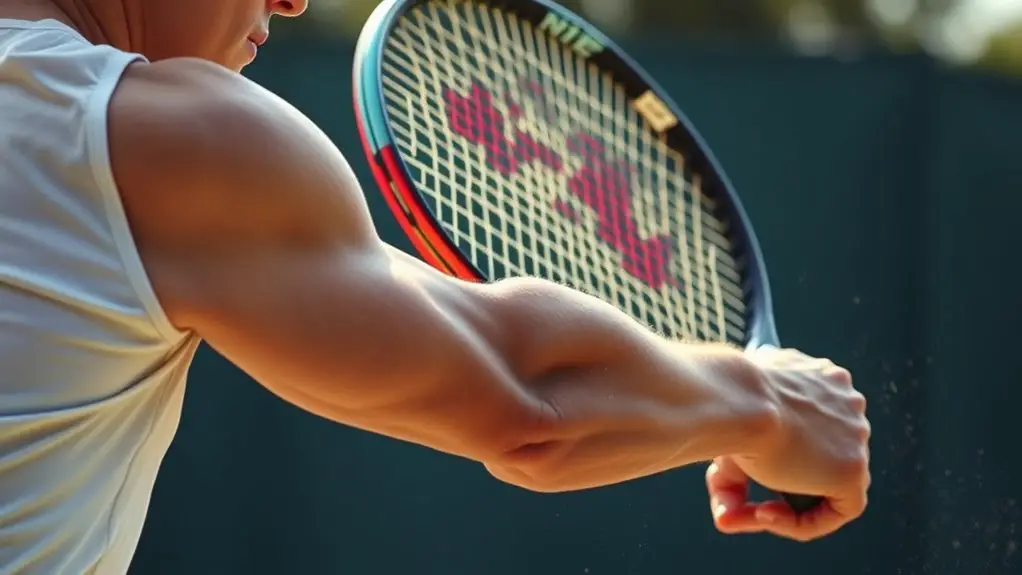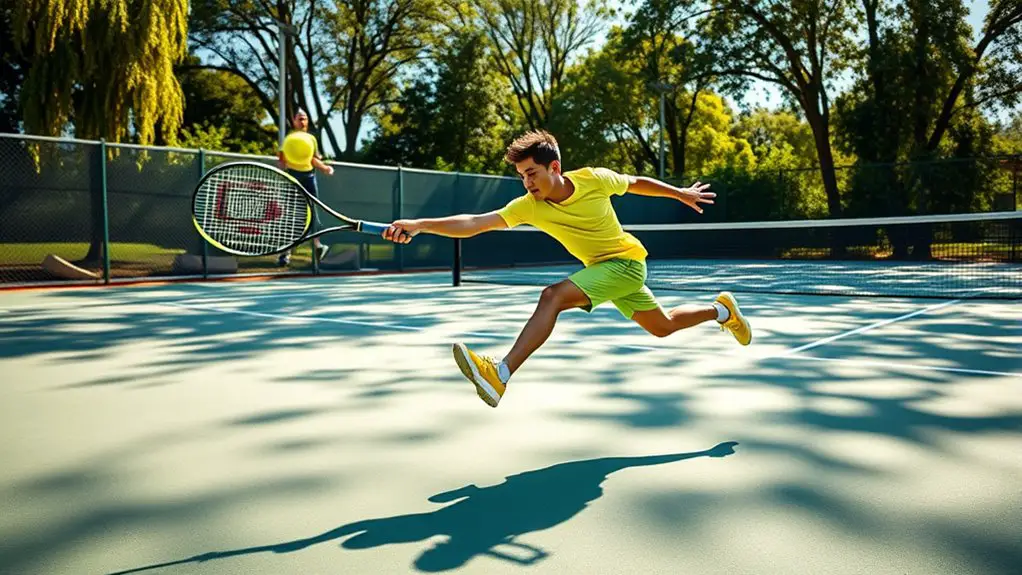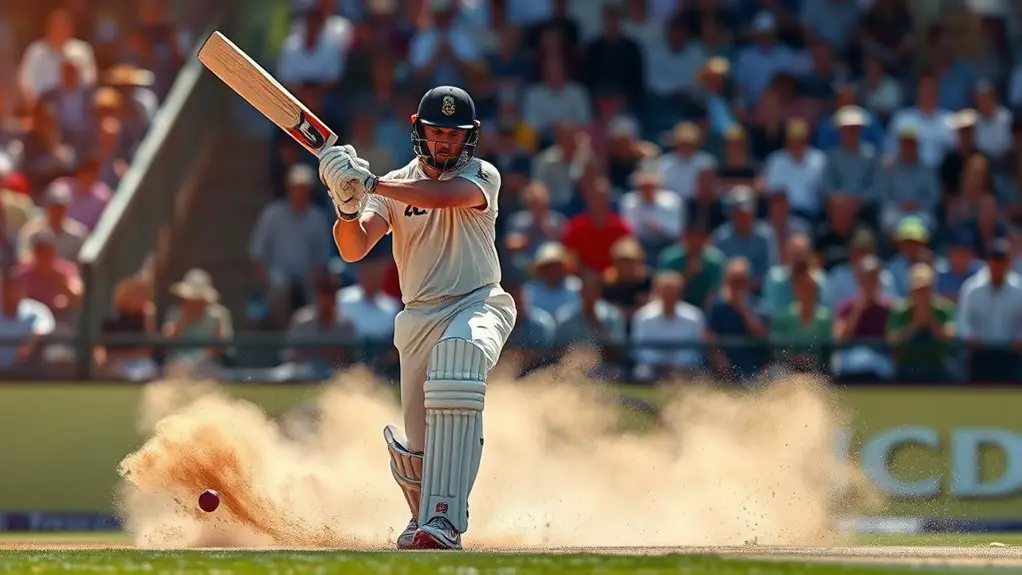To master the biomechanics of a perfect backhand stroke, you need to focus on grip, footwork, and body positioning. Keep your feet shoulder-width apart for balance and guarantee your shoulders align with the net. Your non-dominant hand plays a key role in guiding the racket, while a relaxed grip allows for better control. Timing your hip and shoulder rotation is essential for power. Explore these elements further to enhance your stroke and overall game effectiveness.
Understanding the Backhand Stroke
When you step onto the court, understanding the backhand stroke is essential for improving your game. Mastering backhand mechanics allows you to release your potential, giving you the freedom to explore different stroke variations. Start by gripping the racket correctly; a firm yet relaxed hold sets the stage for fluid motion. As you prepare to strike, focus on your body alignment and positioning. A strong foundation will enhance your power and control.
Experiment with various backhand styles, like the one-handed or two-handed backhand, to find what feels natural for you. Each variation has its advantages, and knowing when to use them can change the game's momentum. By practicing these mechanics and stroke variations, you'll develop confidence on the court. Remember, it's not just about hitting the ball; it's about expressing your unique style while refining your technique. Embrace the journey, and let your backhand shine! Incorporating footwork drills into your training can significantly improve your overall performance.
The Importance of Footwork
Though you might focus on perfecting your swing, footwork is just as essential in executing a successful backhand stroke. If you want to elevate your game, consider these key aspects of footwork:
- Lateral Movement: Mastering lateral movement allows you to position yourself effectively, ensuring you can hit the ball with power and precision.
- Quick Adjustments: The ability to make quick adjustments helps you respond to unexpected shots, maintaining your rhythm and confidence on the court.
- Balance and Stability: Good footwork enhances your balance, enabling you to transfer energy effectively from your legs through your core to your swing. Proper footwork also reduces the risk of injuries, allowing you to maintain peak performance throughout your matches.
Emphasizing footwork gives you the freedom to play dynamically and adapt to your opponent's style. So, don't underestimate its importance—practice your footwork, and watch your backhand stroke transform!
Body Positioning and Balance
Body positioning and balance play an essential role in executing a perfect backhand stroke, ensuring you can generate power and control. When you align your body properly and distribute your weight effectively, you'll feel more liberated on the court.
| Aspect | Importance | Emotion Evoked |
|---|---|---|
| Body Alignment | Enhances stroke accuracy | Confidence |
| Weight Distribution | Increases stability | Freedom to move |
| Balance | Improves follow-through | Empowerment |
To achieve ideal body alignment, keep your shoulders square to the net and feet shoulder-width apart. As you shift your weight onto your back foot, it allows you to harness energy for a powerful swing. Maintaining balance lets you stay grounded, making your movements fluid and instinctive. By mastering body positioning and weight distribution, you're not just playing; you're expressing your freedom on the court. Developing core strength can further enhance your stability and control during the stroke, allowing for more effective execution.
Hip and Shoulder Rotation
When you make a backhand stroke, the rotation of your hips and shoulders plays an essential role in generating power and precision. Core stability is vital for maintaining control and timing your movements effectively. Understanding the sequence in which your upper body rotates can greatly enhance your overall technique.
Importance of Core Stability
Core stability plays an essential role in executing a perfect backhand stroke, as it underpins the necessary hip and shoulder rotation. When you harness core strength, you'll find that it enhances your performance greatly. Focus on these key aspects:
- Core Engagement: Activate your abdominal muscles for better control during the stroke.
- Pelvic Stability: Maintain a stable pelvis to support proper hip rotation while swinging.
- Dynamic Balance: Achieve rotational stability to enable fluid movement throughout your stroke.
Timing of Rotational Movement
Mastering the timing of rotational movement in your backhand stroke is essential for maximizing power and accuracy. To enhance your performance, focus on coordinating your hip and shoulder rotation. The right timing can elevate your rotational speed, ensuring that your stroke packs a punch. Integrating timing drills into your practice routine can help refine this vital aspect.
| Drill Type | Focus Area | Benefits |
|---|---|---|
| Slow Rotations | Awareness of movement | Builds foundational timing |
| Rapid Twists | Speed and agility | Enhances rotational speed |
| Shadow Swings | Muscle memory | Improves coordination |
| Resistance Bands | Strength and control | Increases power |
| Partner Drills | Real-time adjustments | Develops adaptability |
With dedication, you can achieve a fluid backhand that feels effortless.
Sequence of Upper Body
While understanding the sequence of upper body rotation is essential, it's the synchronization of your hips and shoulders that truly enhances your backhand stroke. Mastering this connection can elevate your game and give you the freedom to express your style. Here's how to get it right:
- Initiate with Hips: Start your movement by rotating your hips toward the target, creating a powerful foundation.
- Follow with Shoulders: As your hips lead, allow your shoulders to rotate, aligning them with your lower body for ideal upper body mechanics.
- Finish with Arm Swing: Finally, let your arm swing naturally, driven by the momentum from your hips and shoulders, ensuring a fluid and powerful stroke.
The Role of the Non-Dominant Hand
Although many players focus primarily on their dominant hand during a backhand stroke, the non-dominant hand plays an essential role in achieving balance and control. Your non-dominant hand helps with coordination, guiding the racket into the right position. When you grip the racket with your dominant hand, your non-dominant hand should assist in stabilizing the movement, ensuring your swing remains fluid.
Proper hand positioning is key; it allows you to maintain control over the racket during the stroke. As you prepare for the shot, let your non-dominant hand extend to create a counterbalance. This not only enhances your overall posture but also prepares your body for a more powerful follow-through. By integrating the non-dominant hand into your technique, you'll find greater precision and freedom in your backhand stroke. Embrace the harmony between both hands, and watch your game elevate.
Timing and Rhythm
When you focus on timing and rhythm in your backhand stroke, you'll notice how essential they are for executing a successful shot. Achieving that perfect flow allows you to connect with the ball in a way that feels liberating. To enhance your timing and rhythm, consider incorporating the following techniques into your practice:
Focusing on timing and rhythm in your backhand can transform your game, creating a liberating connection with the ball.
- Timing Drills: Use a metronome to keep a steady beat while practicing your swings. This helps you sync your movements with the rhythm of your shots.
- Rhythm Exercises: Try bouncing a ball on your racket at various tempos. This will develop your ability to maintain a consistent rhythm during play.
- Shadow Swings: Without a ball, practice your backhand stroke focusing solely on the timing and fluidity of your movement.
Grip Techniques for Optimal Control
The grip you choose can greatly impact your control during a backhand stroke. Whether you prefer an Eastern, Western, or Continental grip style, each can influence your feel for the racket and your ability to place the ball accurately. It's crucial to find a grip that feels natural and allows you to express your unique playing style.
Pay attention to grip pressure, too; too tight, and you'll lose fluidity; too loose, and you risk losing control. A relaxed grip can enhance your touch and responsiveness, letting you adapt quickly to your opponent's shots. Incorporating grip strength exercises can further improve your performance and stability on the court. Experiment with different styles and pressures to discover what works best for you.
Generating Power Through Kinetic Chain
Finding the right grip is just the first step; generating power in your backhand stroke relies heavily on the kinetic chain. It's all about harnessing the flow of energy through your body to create maximum impact. To achieve this, focus on these key components:
- Footwork: Your legs initiate the movement. Strong, agile footwork helps you position your body for ideal torque generation.
- Core Engagement: Engage your core to facilitate the transfer of kinetic energy from your lower body through your torso. This connection is essential for a powerful stroke.
- Follow-Through: A complete follow-through allows the energy built up during the swing to release effectively, adding to the stroke's power. Additionally, incorporating functional strength training can further enhance your overall athletic performance and power generation.
Common Mistakes and How to Correct Them
When it comes to your backhand stroke, grip position errors and footwork misalignment can really throw off your game. You might not even realize you're making these mistakes until they start affecting your performance. Let's break down how to identify and fix these common issues.
Grip Position Errors
Although mastering the backhand stroke is crucial for any player, grip position errors can easily undermine your efforts. To elevate your game, pay attention to these common mistakes regarding grip pressure and grip angle:
- Too Tight or Too Loose: Finding the right grip pressure is important. Over-gripping stifles your swing, while a loose grip can lead to loss of control.
- Incorrect Grip Angle: Verify the racket's face is angled correctly. An improper angle can cause mis-hits and inconsistent ball contact.
- Inconsistent Grip: Switching grips mid-game confuses your muscle memory. Stick to a consistent grip for fluidity and confidence.
Footwork Misalignment
Proper footwork is essential for executing a perfect backhand stroke, as misalignment can greatly hinder your performance. Many players overlook foot placement, leading to improper weight distribution and compromised balance. If your feet are too close together or misaligned, you'll struggle to generate power and accuracy.
To correct this, focus on keeping your feet shoulder-width apart, ensuring your weight is evenly distributed. When preparing for the stroke, pivot on your back foot and push off with your front foot, allowing for a smooth transfer of weight.
Frequently Asked Questions
How Can I Improve My Backhand Stroke Quickly?
To improve your backhand stroke quickly, you've got to hit the ground running. Focus on your stroke timing; it's essential for consistency. Work on your body rotation, ensuring your hips and shoulders align with the swing. Practicing regularly will help you find your rhythm and unleash your potential. Don't be afraid to experiment with grips and stances. Remember, each adjustment brings you closer to mastering that stroke and enjoying the freedom of your game.
What Exercises Enhance Backhand Stroke Strength?
To enhance your backhand stroke strength, try incorporating resistance bands into your routine. They'll help build the muscles needed for a powerful swing. Focus on exercises that also engage your core stability, like rotational movements. This'll not only improve strength but also provide you with better control and freedom in your shots. With consistent practice, you'll feel the difference in both power and precision in your backhand stroke.
Is a One-Handed or Two-Handed Backhand Better?
When weighing the wonders of the one-handed or two-handed backhand, consider your comfort and control. One-handed advantages include greater reach and a more fluid follow-through, giving you freedom to express your style. However, two-handed drawbacks can limit your range and flexibility. If you crave creativity on the court, a one-handed backhand might be your ticket to triumph. Ultimately, it's about what feels right for you and your game.
How Does Grip Size Affect Backhand Performance?
Grip size greatly impacts your backhand performance. If your grip's too small or large, it can throw off your grip pressure and technique. Finding that sweet spot helps you maintain better control and stability during your shot. You'll notice that with the right grip size, your swing feels more natural, allowing you to release your full potential. So, experiment with different sizes to discover what works best for your style and enhances your freedom on the court.
Can Age Impact My Ability to Execute a Backhand?
Imagine the thrill of a perfectly executed backhand, your racquet slicing through the air. As you age, age-related changes can impact your ability to perform this stroke. However, don't fret—technique adaptation can help you maintain your game. With a bit of practice and adjustments, you can still enjoy the freedom of hitting that backhand with confidence. Embrace the journey, and let your passion for the game guide you through any challenges.




